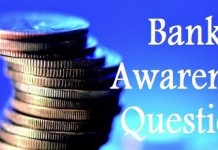Hello Aspirants,
Welcome to Banking Awareness Quiz in AffairsCloud.com. Here we are creating quiz covering important questions which are common for all the bank exams and other competitive exams.
- The structure of the registry which will enable quick sharing of information about unstructured borrowers and help banks fight bad loans. The registry is called _______
A. CIBIL
B. Fraudelent Borrowers List
C. RBI wilful Defaulter List
D. Central Fraud Registry
E. None of the AboveD. Central Fraud Registry
Explanation:
The Reserve Bank of India has operationalised a Central Fraud Registry (CFR). The registry will make available more information to banks at the time of starting a banking relationship, extending credit facilities or at any time during the operation of an account. The CFR is a centralised searchable database which can be accessed by banks. - The record of all economic transactions between the residents of a country and the rest of the world in a particular period is known as _______
A. Balance in Current Account
B. Balance in Capital Account
C. Trade Settlements
D. Balance of Trade
E. Balance of PaymentsE. Balance of Payments
Explanation:
The balance of payments (BOP) is the method countries use to monitor all international monetary transactions at a specific period of time.A record of all transactions made between one particular country and all other countries during a specific time period. - Public Debt Management Agency (PDMA) is being to set up to prevent leakages and development of the ___________
A. Treasury Market
B. Bond Market
C. Money Market
D. Capital Market
E. Call Money MarketB. Bond Market
Explanation:
The government’s intention to set up a Public Debt Management Agency (PDMA) is not only required for the development of the bond market in the country, but it would also prevent leakages of public funds. - The agency which is tasked with collecting analysing and disseminating information related to dubious financial transactions is ________
A. Financial Intelligence Unit(FIU)
B. Financial Action Task Force(FATF)
C. Central Economic Intelligence Bureau(CEIB)
D. Central Intelligence Bureau(CIB)
E. Financial Stability Board(FSB)A. Financial Intelligence Unit(FIU)
Explanation:
The Financial Intelligence Unit (FIU), an agency tasked with collecting, analysing and disseminating information related to dubious financial transactions.The main function of FIU-IND is to receive cash/suspicious transaction reports, analyse them and, as appropriate, disseminate valuable financial information to intelligence/enforcement agencies and regulatory authorities. - Who finalises the value and volume of the notes to be printed every year?
A. Independently by Ministry of Finance
B. Independently by Ministry of Government of India
C. Committee of Bank Heads
D. With Mutual Consultation of the GOI and Bank Heads
E. With Mutual Consultation of the RBI and GOIE. With Mutual Consultation of the RBI and GOI
Explanation:
The Reserve Bank based on the demand requirement indicates the volume and value of banknotes to be printed each year to the Government of India which get finalized after mutual consultation. The quantum of banknotes to be printed, broadly depends on the requirement for meeting the demand for banknotes, GDP growth, replacement of soiled banknotes, reserve stock requirements, etc. - e-KYC is possible only for those who have _______
A. PAN Card
B. Driving License
C. Ration Card
D. Aadhaar Number
E. None of the AboveD. Aadhaar Number
Explanation:
e-KYC is possible only for those who have Aadhaar numbers. While using e-KYC service, you have to authorise the Unique Identification Authority of India (UIDAI), by explicit consent, to release your identity/address through biometric authentication to the bank branches/business correspondent (BC). The UIDAI then transfers your data comprising name, age, gender, and photograph of the individual, electronically to the bank/BC. - An open source platform for mobile-to-mobile fund transfers without account details launched by NPCI was ________
A. Unified Payment Interface
B. Union of Payment Interface
C. Payment Interface
D. Unique Payment Interface
E. People’s Payment InterfaceA. Unified Payment Interface
Explanation:
UPI allows you to pay directly from your bank account to different merchants without the hassle of typing your card details, or netbanking/wallet password. - The practice of lending money to unrelated individuals, or “peers”, without going through a traditional financial intermediary such as a bank or other traditional financial institution is called__________
A. B2B transactions
B. C2C transactions
C. P2P lending
D. PPP Model
E. P2P InvestingC. P2P lending
Explanation:
P2P lending, is the practice of lending money to individuals or businesses through online services that match lenders directly with borrowers. - Banks can not generally accept interest-free deposits. which of the following is an exception to this rule?
A. Current Account
B. Savings Account of Minors
C. Deposit from Minority groups
D. BSBDA
E. None of the AboveA. Current Account
Explanation:
Banks cannot accept interest free deposits other than in current account. - Deposits under Foreign Currency Non-Resident(FCNR) scheme can be accepted for a minimum of________
A. Six months
B. Three months
C. One year
D. 15 days
E. None of the AboveC. One year
Explanation:
The deposits should be accepted under the Foreign Currency Non-Resident(FCNR) Scheme for the following maturity periods:
One year and above but less than two years
Two years and above but less than three years
Three years and above but less than four years
Four years and above but less than five years
Five years only
AffairsCloud Recommends Oliveboard Mock Test
AffairsCloud Ebook - Support Us to Grow
Govt Jobs by Category
Bank Jobs Notification


